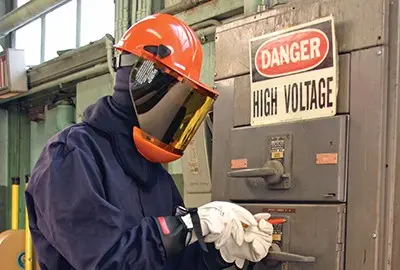Arc Flash Definition
By R.W. Hurst, The Electricity Forum

NFPA 70e Training - Arc Flash
Our customized live online or in‑person group training can be delivered to your staff at your location.

- Live Online
- 6 hours Instructor-led
- Group Training Available
Download Our OSHA 4474 Fact Sheet – Establishing Boundaries Around Arc Flash Hazards

- Understand the difference between arc flash and electric shock boundaries
- Learn who may cross each boundary and under what conditions
- Apply voltage-based rules for safer approach distances
Arc Flash Definition explains the high-energy electrical arc hazard, incident energy, NFPA 70E standards, PPE selection, boundary limits, OSHA compliance, and risk assessment procedures in switchgear, panels, energized equipment, and labeling.
Basics of Arc Flash Definition in Electrical Engineering
Arc flash definition, according to National Fire Protection Association (NFPA), is “a dangerous condition associated with the release of energy caused by an electric arc.” AF typically occurs when the electrical insulation or isolation between live conductors is severed or can no longer withstand the applied voltage. How easy is it to cause an electrical explosion? More easy than you think. Arc faults can result from something as small as inserting a tool in the wrong place, or accidentally dropping a tool of some kind into a circuit breaker or electrical service area. In fact, an explosion can occur under any of the following conditions: a) for instance, an electrical worker is operating on or near energized conductors or circuits, or b) he/she moves near or contacts the equipment, or c) equipment failure occurs; any of these various conditions may cause a phase-to-ground and/or a phase-to-phase electrical fault and the result can be an arc flash/arc blast accident. For additional context, resources that explain the meaning of arc flash can help reinforce these fundamentals.
Visit Our AF Course Page:
electricityforum.com/electrical-training/arc-flash-training
Those new to the topic may start with what is arc flash to build a solid foundation before diving deeper.
The thermal temperature of an explosion can reach more than 5000 degrees. This energy is in the form of a blinding flash of light and a deafening noise. In this explosion, a giant amount of concentrated energy is forced outward from the electrical equipment toward the electrical worker, spreading hot gases and molten metal. Understanding the difference between an electrical arc blast and an arc flash clarifies the distinct hazards involved.
FREE EF Electrical Training Catalog
Download our FREE Electrical Training Catalog and explore a full range of expert-led electrical training courses.

- Live online and in-person courses available
- Real-time instruction with Q&A from industry experts
- Flexible scheduling for your convenience
Every day in the United States, from five to 10 AF explosions happen. These explosions cause injuries (from the creation of pressure waves that can damage hearing or brain function and a flash that can damage eyesight and burn exposed and covered flesh) which can range from minor burn injuries to life threatening injuries and possible death. In addition to the electrical worker being injured, the fast-moving pressure wave can also injure other workers in the vacinity who can be struck by loose material such as pieces of equipment, metal tools, and other projectiles. Case studies on arc flash injuries underscore the severity of burns, hearing damage, and vision loss.
In addition to personal injury, AF can result in serious damage to electrical equipment from short circuit. which can cause disruption to electrical systems in manufacturing and process industry environments,office buildings, or institutions such as hospitals, airports, schools, etc. The cost from downtime can be considerable. A broader overview of electrical arc flash also addresses business continuity and asset protection considerations.
Accidents usually take place in situations above 120V, and often happens during the service or inspection for normal wear and tear of electrical equipment. In fact, some accidents occur when an electrical worker removes a cover from an electrical device. Many electrical service companies recommend that electrical equipment be de-energized before any service or maintenance work is started, although this is not always possible but it is always safest to work with some kind of protective device in place. Detailed explanations of how an arc flash occurs highlight the roles of voltage, conductor spacing, and human error.
NFPA 70e recommends the establishment of a clearly defined “flash protection boundary” and then dictates a way to calculate such a boundary. This imaginary personal protection boundary, which surrounds the potential arc point, specifies what level of personal protective equipment ppe clothing and equipment must be worn by a qualified electrical worker who enters within that flash protection boundary. NFPA 70e defines a “flash protection boundary within which a person could receive a second-degree burn if an electrical arc flash were to occur." It also gives a definition for incident energy as “the amount of energy impressed on a surface, a certain distance from the source, generated during an electrical arc event.” For practical applications, summaries of NFPA 70E arc flash provisions outline PPE categories, boundaries, and labeling practices.







